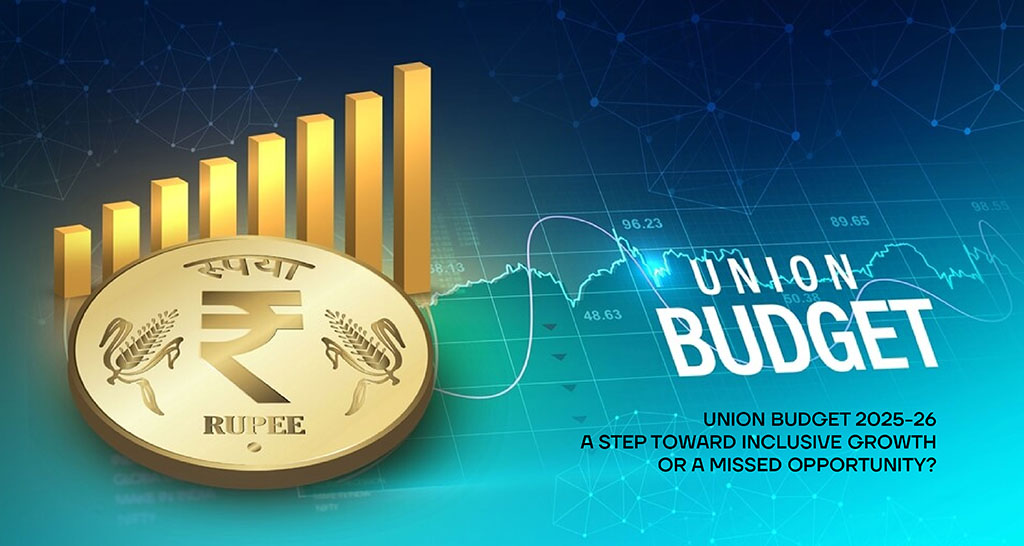India’s Union Budget for the fiscal year 2025-26 has generated considerable anticipation, reflecting the nation’s intricate economic challenges and its lofty growth ambitions. As India strives to bolster its economy and position itself as a global leader, the budget plays a crucial role in determining the country’s path for the upcoming fiscal year. The primary concern, however, is whether the initiatives outlined in the budget will foster an inclusive economic growth model that guarantees equitable prosperity for all segments of society, particularly for marginalized and vulnerable populations.
An Overview of the Union Budget 2025-26
The Union Budget for 2025-26, introduced by the Finance Minister in February 2025, seeks to tackle the dynamic economic challenges facing India, which include unemployment, rural distress, income inequality, inflationary pressures, and the need for environmental sustainability. Although the budget proposes various initiatives and reforms in sectors such as healthcare, education, infrastructure, and agriculture, a significant concern remains regarding the potential for these measures to foster a genuinely inclusive growth path.
The government has pledged to undertake significant investments in rural development, social infrastructure, and job creation, which theoretically corresponds with the objectives of diminishing inequality and promoting inclusive prosperity. Furthermore, the budget establishes ambitious economic growth targets, intending to strengthen India’s status as one of the fastest-growing economies globally.
Focus on Social Welfare and Infrastructure
A significant aspect of the 2025-26 budget is its focus on enhancing social welfare initiatives. The Finance Minister revealed an increase in funding for essential programs, including the Pradhan Mantri Awas Yojana (PMAY), aimed at delivering affordable housing to economically disadvantaged populations, as well as the National Health Mission, which will receive a considerable boost in resources to improve healthcare accessibility in rural and underserved areas.
A significant aspect of this initiative is the allocation of direct financial support to low-income households, anticipated to alleviate the hardships faced by millions of individuals striving to meet their basic needs. Furthermore, efforts to generate employment opportunities in rural and semi-urban regions have been enhanced, encompassing assistance for small enterprises, skill enhancement initiatives, and projects focused on rural industrialization.
Infrastructure development, especially in rural regions, has received considerable attention through a proposal aimed at enhancing connectivity and improving access to essential services, including clean drinking water, sanitation, and electricity. The implementation of these infrastructure initiatives is anticipated to yield a dual benefit: stimulating economic growth while simultaneously meeting the needs of disadvantaged populations.
The Challenge of Employment Generation
Although these advancements are noteworthy, the challenge of unemployment, particularly among young people and women, persists as a significant issue. The labor market in India continues to face difficulties, including underemployment, informal work, and a mismatch of skills. While the budget outlines various initiatives intended to generate employment, detractors contend that these efforts may fall short or lack the necessary focus to effectively address the magnitude of the problem.
The emphasis on infrastructure initiatives has the potential to create employment opportunities however, a significant number of these roles are likely to be low-wage or temporary. Furthermore, the long-term viability of such positions is uncertain unless there is a simultaneous effort to enhance labor standards and offer social security benefits to workers in the informal sector, which represents a substantial portion of India’s labor force.
Agriculture and Rural Development: A Mixed Bag
The agricultural sector, which serves as the foundation of India’s economy, has been highlighted in the budget for 2025-26. Considering the difficulties faced by this sector, including low crop prices, water shortages, and insufficient infrastructure, the government has designated financial resources to improve irrigation systems, facilitate enhanced market access for farmers, and promote the shift towards sustainable agricultural practices.
Experts contend that, although these reforms are praiseworthy, they may fall short in tackling the more profound structural challenges within the agricultural sector. While enhancing infrastructure and providing support to smallholder farmers is essential, the budget fails to present significant measures to confront the issues of farmer debt, land fragmentation, and the insufficient diversification of rural economies.
Environmental Sustainability and Green Growth
One additional domain in which the budget seems to show progress is in the realm of environmental sustainability. Acknowledging the increasing apprehensions surrounding climate change and the necessity for sustainable development, the government has designated significant financial resources for projects related to renewable energy, clean transportation, and waste management efforts. The encouragement of electric vehicles (EVs), solar energy, and energy-efficient technologies represents a constructive advancement toward enhancing the environmental sustainability of India’s growth.
Critics argue that although the budget incorporates green initiatives, it falls short in providing specific policy measures to tackle urgent challenges such as pollution, deforestation, and the wider effects of industrialization. While the emphasis on green technologies is significant, it must be supported by robust regulatory frameworks and long-term sustainability objectives.
Conclusion: A Step Toward Inclusive Growth or a Missed Opportunity?
The Union Budget for 2025-26 introduces a combination of encouraging initiatives designed to stimulate economic growth and enhance social welfare. Nevertheless, the actual impact of these measures on achieving genuinely inclusive growth is yet to be determined. Although the emphasis on rural development, infrastructure, and social welfare programs represents a positive advancement, the absence of significant reforms in areas such as employment generation, agriculture, and digital inclusion may hinder the success of these initiatives.







